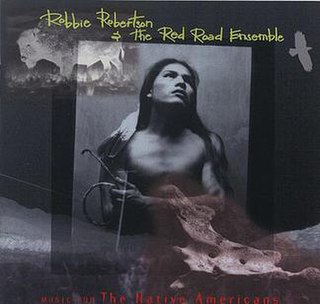
The Innu / Ilnu or Innut / Innuat / Ilnuatsh ("people"), formerly called Montagnais from the French colonial period, are the Indigenous inhabitants of territory in the northeastern portion of the present-day province of Labrador and some portions of Quebec. They refer to their traditional homeland as Nitassinan or Innu-assi.

Sept-Îles is a city in the Côte-Nord region of eastern Quebec. It is among the northernmost locales with a paved connection to the rest of Quebec's road network. The population was 25,686 as of the 2011 Canadian census. The town is called Uashat, meaning "bay" in Innu-aimun.
Indigenous music of Canada encompasses a wide variety of musical genres created by Aboriginal Canadians. Before European settlers came to what is now Canada, the region was occupied by many First Nations, including the West Coast Salish and Haida, the centrally located Iroquois, Blackfoot and Huron, the Dene to the North, and the Innu and Mi'kmaq in the East and the Cree in the North. Each of the indigenous communities had their own unique musical traditions. Chanting – singing is widely popular and most use a variety of musical instruments.
Maliotenam is a First Nations reserve in Quebec, located adjacent to the city of Sept-Îles. Together with Uashat some distance away, it forms the Innu community of Uashat-Maliotenam. The community is a part of the Manicouagan district which is represented by Bloc Québécois MP Marilène Gill. The community has a population of approximately 1,600 people.
The Innu are among the First Nations of Canada. They have maintained a vibrant folk music culture, especially involving dance and percussion-based music. Philip Mackenzie is an especially important modern musician, known for being the creator a kind of singer-songwriter tradition using the Innu language. Though he originally used only guitar and teueikan, subsequent performers in his folk Innu style have added electronic and acoustic instruments.

Florent Vollant is a Canadian singer-songwriter. An Innu from Maliotenam, Quebec, he was half of the popular folk music duo Kashtin, one of the most significant musical groups in First Nations history. He has subsequently released four solo albums.
Claude McKenzie is a Canadian singer-songwriter. An Innu from Maliotenam, he was half of the popular folk music duo Kashtin, the most commercially successful musical group in First Nations history.
Innu-aimun or Montagnais is an Algonquian language spoken by over 10,000 Innu in Labrador and Quebec in Eastern Canada. It is a member of the Cree–Montagnais–Naskapi dialect continuum and is spoken in various dialects depending on the community.

William Lawrence Dunn was a Canadian singer-songwriter, film director and politician. Born in Montreal, he was of mixed Mi'kmaq and Scottish/Irish background. Dunn often highlighted indigenous issues in his work.
The Juno Awards from 1992, were awarded on 29th of March in Toronto at a ceremony in the O'Keefe Centre. Rick Moranis was the host for the ceremonies, which were broadcast on CBC Television from 9 pm Eastern.
The Juno Awards of 1995 was an awards show representing Canadian music industry achievements of the previous year. It took place on 26 March 1995 in Hamilton, Ontario at a ceremony in the Copps Coliseum. Mary Walsh, Rick Mercer and other regulars of the television series This Hour Has 22 Minutes were the hosts for the ceremonies, which were broadcast on CBC Television. Almost 10,000 people were in attendance, and over 6,500 public tickets were sold. It was the first time the Awards event was open to the public.

Music for The Native Americans is a 1994 album by Robbie Robertson, compiling music written by Robertson and other colleagues for the television documentary film The Native Americans. The album was Robertson's first foray into writing music specifically inspired by his Mohawk heritage. Robertson brought in his son Sebastian Robertson to handle the drums on "Golden Feather", "Skinwalker", "It Is a Good Day to Die" and "Words of Fire, Deeds of Blood". His daughter Delphine Robertson sings backing vocals on "Coyote Dance".

Kashtin is the debut album by Canadian folk rock duo Kashtin, released in 1989. The album featured the hit singles "Tshinanu" and "E Uassiuian".

Akua Tuta is the third album by Canadian folk rock duo Kashtin, released in 1994. Akua Tuta was the final album released by the band under the name Kashtin, although band members Claude McKenzie and Florent Vollant have each continued to record as solo artists.

Samuel Tremblay, better known by his stage name Samian, is a Canadian rapper who performs in both French and Algonquian.

Innu is the second album by Canadian folk rock band Kashtin, released in 1991. The album was certified platinum in Canada, and was a shortlisted Juno Award nominee for the Best World Beat Recording and Best Roots and Traditional Album awards at the Juno Awards of 1992.
Innu Takuaikan Uashat Mak Mani-Utenam is an Innu First Nations band government in Quebec, Canada. It is based in Sept-Îles in the Côte-Nord region on the North shore of the Saint Lawrence River. It owns two reserves: Maliotenam 27A and Uashat 27 located at both ends of Sept-Îles. It is governed by a band council and is a member of the Mamuitun Tribal Council.
Shauit is a Canadian singer-songwriter, who blends traditional First Nations music, primarily in the Innu-aimun language, with pop-rock and reggae music.

Innu Nikamu: Resist and Sing is a Canadian documentary film, directed by Kevin Bacon-Hervieux and released in 2017. The film is a profile of Innu Nikamu, an Innu music festival which is held on the grounds of the former Sept-Iles Indian residential school. Musical figures appearing in the film include Shauit, Florent Vollant and the rock band Simple Plan.
Innu Nikamu is an annual music festival, staged in the Innu community of Mani-Utenam near Sept-Îles, Quebec. Launched in 1985 by a community group that included musician Florent Vollant of the prominent local band Kashtin, the festival programs an annual lineup of Indigenous Canadian music and culture, staged on the grounds of the former Sept-Îles residential school.










